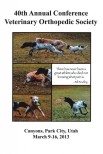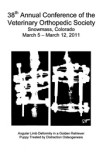Objective: The objective of this study was to evaluate a radiographic technique for differentiating normal feline sacroiliac joints from those with unilateral luxation.
Materials and methods: Fifty normal feline pelvic radiographs (control group) and 50 radiographs with unilateral sacroiliac luxation (luxation group) were assessed. Three angles were measured on each radiograph using a reference line connecting the most cranial aspect of the iliac wings and three anatomical landmarks: the cranial endplate of lumbar vertebra 6, the caudal endplate of lumbar vertebra 6 and the cranial endplate of lumbar vertebra 7. Study feasibility was assessed by a single observer on 20 radiographs per group. In the second phase, measurements were obtained from 30 radiographs per group and recorded twice by three blinded observers, with a 4-week interval between assessments. Angular differences between groups were analysed, along with optimal cut-off values, diagnostic performance and inter- and intra-observer reliability.
Results: All three measured angles were significantly smaller in the control group than in the luxation group. Specifically, angular measurements exceeding 2.3° at the cranial endplate of lumbar vertebra 6, and 2.4° at both the caudal endplate of lumbar vertebra 6 and the cranial endplate of lumbar vertebra 7, were indicative of unilateral sacroiliac luxation. The respective sensitivity and specificity values of the aforementioned cut-off angles were 90% and 97% for the first, 90% and 94% for the second and 86% and 94% for the third. These thresholds were associated with consistently high inter- and intra-observer reliability.
Clinical significance: These proposed angular cut-offs provide a reliable diagnostic criterion for identifying unilateral sacroiliac luxation in cats and may enhance diagnostic confidence and accuracy, particularly in primary care settings where radiography remains the preferred imaging modality for feline pelvic injuries.









